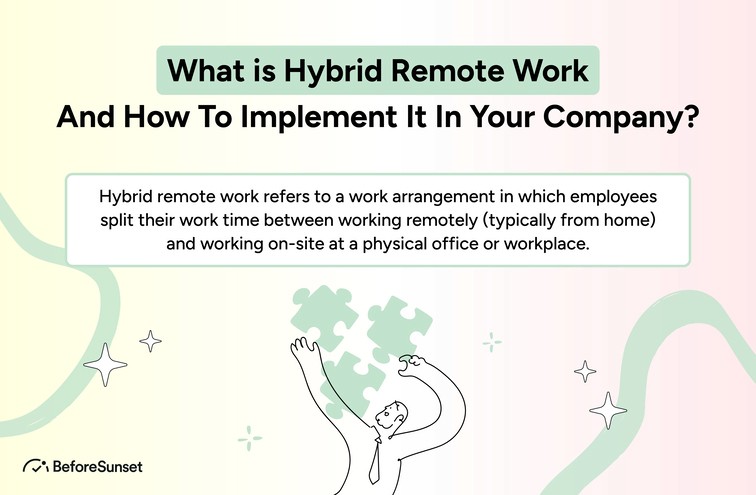In the contemporary workplace, the idea of hybrid remote work has arisen as a paradigm shifter, providing firms with a flexible and adaptive method of blending in-office and remote work arrangements. With the help of this ground-breaking approach, staff members can combine the advantages of working from home with those of face-to-face interaction, which boosts output, improves work-life balance, and builds a more resilient workforce.
Understanding what hybrid remote work comprises and how to successfully adopt it within your business is essential as the lines between regular office-based work and remote work continue to blur.
This blog looks into the nuances of hybrid remote work, illuminating its definition, advantages, and difficulties as well as the tactical actions required to successfully implement this flexible work arrangement into the culture and operations of your company.
Businesses may take advantage of the promise of a blended work environment that responds to the different requirements of workers while spurring innovation and organizational success by navigating the subtleties of hybrid remote work.

Company Culture and Employee Engagement
The common values, beliefs, behaviors, and customs that form an organization's identity and direct its relationships both internally and externally are collectively referred to as company culture. Employee interactions, choices, and alignment with the company's goal are all built on this basis.
This is complemented by the idea of employee engagement, which refers to the emotional dedication and zeal that employees feel for their jobs, coworkers, and the business as a whole.
High levels of employee engagement increase job satisfaction, productivity, and creativity, which all contribute to a productive workplace that encourages success and development.
Establishing a Positive Company Culture
Building and maintaining a healthy workplace culture is a crucial task that has a big impact on both the success of a firm as a whole and the wellbeing of its employees. A strong business culture is more than simply a collection of catchphrases; it's a set of guiding principles, attitudes, and conduct that affects how people work and relate to one another.
Companies may build the foundation for a flourishing working environment where workers are motivated, engaged, and in line with the company's vision by purposefully developing and cultivating this culture.
The expression and living out of fundamental values are the cornerstones of creating a strong workplace culture. These principles work as a compass to direct decisions and actions throughout the corporation.
Employees feel a feeling of purpose and belonging when they are aware of and connect with these principles. Particularly in establishing the tone for the corporate culture, leaders play a crucial role. Employees may learn by their activities and behaviors, which reinforce the significance of the stated principles.
A strong corporate culture also emphasizes open communication. Employees may express their ideas, issues, and comments by creating open channels for communication.
Everyone is kept informed and involved through regular communication about the company's objectives, accomplishments, and difficulties, which promotes a sense of shared responsibility and ownership.
Additionally, leaders that actively listen to employee viewpoints show that their opinions are respected, which fosters higher engagement and trust.
For the purpose of fostering a healthy culture, the employees must be empowered. Giving workers the freedom to decide how to carry out their responsibilities while trusting their knowledge and skills is empowering.
When this empowerment is coupled with a clear knowledge of expectations and support, it motivates workers to take initiative and make significant contributions to the success of the company. A culture of appreciation and motivation is created when excellent behavior and contributions are further reinforced through recognition and awards.
Maintaining Employee Engagement in a Hybrid Model
A careful and flexible strategy is required to maintain employee engagement in a hybrid work style where team members rotate between remote and in-person work. It becomes crucial to maintain open lines of communication in order to keep both office-based and remote workers informed and connected.
Utilizing technology to conduct virtual team-building exercises, work on joint projects, and keep in touch on a regular basis helps close the distance between people and promotes togetherness. A common purpose is reinforced and a strong organizational culture is fostered by putting a heavy emphasis on the organization's fundamental values and mission.
Regardless of location, offering chances for skill development, career progression, and recognition further exemplifies a commitment to the professional improvement of all workers. Equity and work-life balance are ensured by taking a flexible approach to work scheduling and taking into account any time zone disparities.
Person interaction is a must in remote workforce even If they don't have a physical office and have flexible schedules. A remote work mdel can increase employee satisfaction within the office hours.
Companies may maintain high levels of engagement in a mixed work paradigm by placing a priority on clear communication, cooperation, recognition, and advancement.
The Role of Leadership in a Hybrid Model
Effective leadership is essential to navigating the challenges of leading teams that are distributed both virtually and physically in a hybrid work environment.
The organization's culture is shaped by its leaders, who also have an impact on how staff members adjust to this new method of working. They must strike a balance between granting freedom and direction, encouraging teamwork, and upholding a feeling of oneness.
In a remote model, communication is essential to team leaders and hybrid workers. Regardless of where they are in the team, leaders should make sure that everyone has access to timely and accurate information. Clear communication about expectations, objectives, and corporate changes puts everyone on the same page and helps avoid misunderstandings.
Setting a good example is equally important. Leaders that support the hybrid model and show dedication to its success inspire others to follow suit. This entails employing technology for remote work, taking part in online meetings, and demonstrating a desire to learn new techniques for productivity.
In a flexible work model, effective leadership is characterized by empowerment. No matter where they are located, giving workers the freedom to manage their work successfully develops a sense of ownership and accountability. Providing team members with the authority to make choices and offer their knowledge boosts morale and productivity.
In a hybrid approach, developing and maintaining team cohesiveness is another crucial part of leadership. Leaders must devise creative means of fostering interactions and connections amongst team members who may not be present in the same co-working spaces. Regular check-ins, collaborative projects, and virtual team-building exercises can help close the communication gap and promote a sense of belonging.

Scheduling Considerations
With the introduction of hybrid and remote work models, wherein employees alternate between remote and in-person work arrangements, the working environment has experienced a substantial upheaval. A variety of scheduling factors have emerged as a result of this paradigm change, challenging conventional ideas of the workweek.
The art of scheduling in a mixed work environment takes center stage as firms struggle to strike a balance between flexibility and operational demands and people work to reconcile work and personal life.
The mechanics of scheduling in hybrid work arrangements are complicated and have many facets, from cultivating work-life balance to providing equal chances for everybody and optimizing cooperation across time zones.
Setting Flexible Hours for In-Office Employees
Employees who work in offices with flexible hours might arrange their workdays to better fit their daily routines and obligations. This might involve choosing select days to be present in the office, reduced workweeks, or even staggered start and end hours.
Employers realize that strict adherence to set hours may make it difficult for employees to balance their personal and professional duties, which is why they provide such flexibility.
Employers, managers, and workers must collaborate and communicate well in order to implement flexible hours. It entails setting core working hours during which staff members must be present for meetings and cooperation while giving them discretion over the remaining portion of their schedule.
Employees are given the tools to maximize their productivity and creativity when they are feeling the most motivated and concentrated, which improves work performance and happiness.
Additionally, flexible work schedules support a supportive workplace culture. They exhibit faith in workers' capacity for responsible time management, encouraging a sense of independence and ownership. Higher morale, better employee retention, and a reputation as a company that values its employees' well-being can all result from using this strategy.
Setting Flexible Hours for Remote Employees
Allowing remote workers to set their own work schedules and remote work setting depending on their preferences and energy levels is a crucial part of embracing flexible hours. This method acknowledges that not everyone is most productive at the same times and that allowing for flexibility can result in more effective job outputs.
This empowerment is consistent with the nature of remote work policy, where output frequently takes precedence over rigorous adherence to set timeframes.
Flexible work schedules for remote workers need to strike a balance between independence and teamwork. Although individuals are allowed to choose their own work schedules, it's crucial to designate core hours for team cooperation and communication.
Even when remote team members are dispersed across several time zones, these core hours enable real-time communication and preserve a sense of connectedness.
Flexible work schedules for remote workers have several advantages. With this strategy, people may more effectively manage their personal commitments, such as family obligations and professional growth goals.
By enabling workers to organize their work around their most productive and concentrated moments, it also promotes mental wellbeing by lowering burnout and stress.

Teams and Meeting Structures
Rethinking team dynamics and meeting arrangements is crucial in the environment of hybrid work models, where employees rotate between remote and in-person work, in order to enhance cooperation, communication, and productivity. These structures must change to meet remote employees' particular demands as well as the advantages of face-to-face contact.
Virtual Teams and Tools: Teams engaged in hybrid workplace are frequently distributed geographically. Digital collaboration tools are a critical component of communication, project management, and document sharing for virtual teams. Face-to-face communication is made possible via video conferencing tools, which aid in bridging the communication gap between online and in-person team members.
Flexibility and Scheduling: To accommodate various time zones and working hours, teams may need to be more flexible when arranging meetings. Combining synchronous and asynchronous communication allows team members to participate when it is most convenient for them, fostering cross-location cooperation.
Regular Check-ins: Regular virtual check-ins make sure that everyone in the team is in sync and up to date on the status of the project. Some of the unexpected workplace encounters that could be missed in hybrid arrangements can be replaced by these succinct, concentrated sessions.
Hybrid Meetings: It's critical to make the most of team meetings that take place in person. Concentrate on interactions that need physical presence, such as conversations, brainstorming sessions, and relationship-building activities. It gives options for employees who do not have office days or an office environment. An office experience can be achieved without the office days.
Rotating On-Site Days: Setting aside particular days for in-office attendance might improve planning and coordination for teams whose members alternate between remote and in-person work. As a result, team members are always available for face-to-face meetings and cooperation.
Agenda-driven Meetings: In hybrid contexts, well-defined agendas are even more important. Making the most of everyone's time at meetings, whether they take place in person or remotely, means ensuring that they have a goal, results, and actionable items.
How BeforeSunset AI Helps With Hybrid Remote Work
With BeforeSunset AI's up-and-coming team function, working hybrid will be a breeze. Try hybrid work models with BeforeSunset AI.


